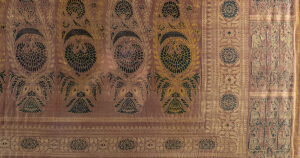 IP met me at Avalon Conservation Labs in Goleta with an antique piece of tapestry, about forty-two-inch square, framed inside a Lucite box. He got it from a family involved with a major museum so thought it worth preserving. Yet he knew nothing about it. This beautiful tapestry lived in a closet. He paid me to investigate.
IP met me at Avalon Conservation Labs in Goleta with an antique piece of tapestry, about forty-two-inch square, framed inside a Lucite box. He got it from a family involved with a major museum so thought it worth preserving. Yet he knew nothing about it. This beautiful tapestry lived in a closet. He paid me to investigate.
Repeated images of six holy men or sages riding in little chariots line the edges. The center of the cloth features a line of paisley. The correct name is boteh. Paisley is the modern European name after a town in Scotland where loomed cloth as a design feature in the 19th century. The 16th century Persian origination design symbolizes life, fertility, eternity and the spiritual East. Seed-like shapes represent newness and enlightenment. Let’s put these symbols together and see if we ascertain the origin and function of this tapestry
A Great Deal Of Meaning
This rare, almost perfect example of a Hindu shrine cloth which covered an idol of a deity inside of their shrine in a place of worship. It’s late 18th early 19th century, and bears a great deal of meaning. I discovered 18th and 19th century Indian paintings with a similar theme as the tapestry portraying a main character from the Mahabharata. Arjuna famously went to war in a chariot driven by the god Krishna.
Chariots “carry” a multiplicity of meanings because the Sanskrit word “Ratha” means chariot, or car. It also means our bodies and limbs, as well as spiritual elements that transport us, such as love and delight. Thus, the chariot in Hindu literature symbolizes the concept of the human body as a vehicle, with the mind and intellect as the charioteer. The holy book called Upanishads notably described as such a metaphor in the Ratha Kalpana story. The story explains the concept of self-control and the need to steer one’s mind and senses towards spiritual liberation.
Chariots feature prominently in the Vedas, the Puranas, and the great epics the Ramayana and the Mahabharata. A potent symbol from antiquity, the chariot, dating to the Vedas over 3,500 years ago, is ideal for a cloth woven to safeguard a deity and to remind a devotee of the spiritual path, accompanied by the wisdom of the Rishis. In fact, huge chariots in Hindu holy festival parades often bring the idol of the deity to a shrine. Hindus used these processional temple chariots since antiquity. Myth holds that Hindu gods also ride in such conveyances, such as the deity Dawn (Usha) who rides with his messenger Agni, the god of fire and communication.
Woven Chariots Correctly Depicted?
Nobody knows exactly how the Vedic chariot was built because the Vedas were composed between 1500-1200 BCE. The oldest book of the four, the Rigveda, featured many such chariots. The Vedas (Wisdom) are among the oldest Hindu sacred texts, written in Sanskrit in the Punjab region of India.
My favorite chariot story, “The Chariot of Arjuna,” from the Mahabharata, begun in the 3rd C BCE. The tale involves two mighty warriors related to each other, Arjuna and Karna. The god Krishna is Arjuna’s (a mortal) charioteer. Karna, also a mortal, lacks divine protection but is a fierce opponent. Krishna himself marvels to Arjuna over Karna’s power, but Arjuna receives scant praise from the god. After the battle is over, Ajuna prevailing, the god and the man dismount. The chariot crumbles to soot and dust. Krisha explains to Arjuna that Karna had set fire to his chariot miles back, and Krishna’s protection allowed Arjuna to stay mounted and fighting. Krishna says “It was I who was protecting it; you have not achieved great heights on your own, so be humbled and grateful. When you achieve a decisive battle, it is because of divine intervention.”
I found it difficult to find any such remarkable temple shrine cloths outside of textile museums, such as the George Washinton University Textile Museum, especially not ones for sale, yet paintings similar to this used as devotional images from this period sell for $3,000-$4000 when of his quality.